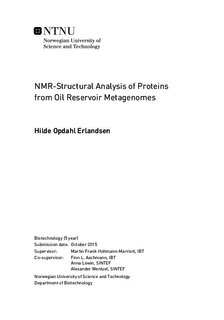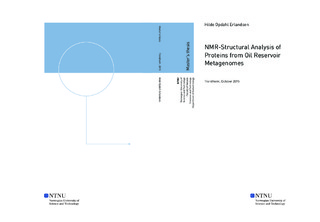| dc.description.abstract | Microorganisms are found ubiquitously around the world, where they survive as a result of their specialized biochemical reactions and enzymes. In the extreme environment of deep sea oil reservoirs, the microbes have to withstand difficulties such as endo- and exogenous toxins, as well as physical extremes (e.g. high temperature and pressure). The aim of this study was to identify putative novel enzymes suitable for NMR spectroscopy (by use of bioinformatic tools), from a translated metagenomic sequence database made of microorganisms obtained from such a reservoir. The proteins were to be of well characterized protein families, and to be studied by thermostability as well as NMR analysis to examine the proteins stability, integrity, purity and fold. This is important to further the understanding of their adaptations to high temperature and pressure, compared to their mesophilic counterparts. Identified proteins were to be heterologously expressed (with and without a His-tag) and purified prior to characterization with NMR spectroscopy, and thermo-exclusion analysis. Five candidates were found in the metagenomic database, namely Ars1, Ars2, Ars3, Glx1 and Glx2 of the ArsC and GlxI protein families. The three candidates Ars1, Ars2 and Glx1 (the two latter with a His-tag) were heterologously expressed in both isotope labeled and non-isotope labeled versions. The Glx1-His protein seemed to be thermostable up to 60 °C, but the NMR results showed no indication of structure. The NMR spectra for Ars1 and Ars2-His show that these candidates seem to be folded and may therefore have potential for more detailed NMR-based structural analysis. In addition, Ars1 appear to be thermostable while Ars2-His does not. Thus only the Ars1 candidate might be used to provide more insight to the thermophilic and piezophilic characteristics of these polyextreme proteins. | |

